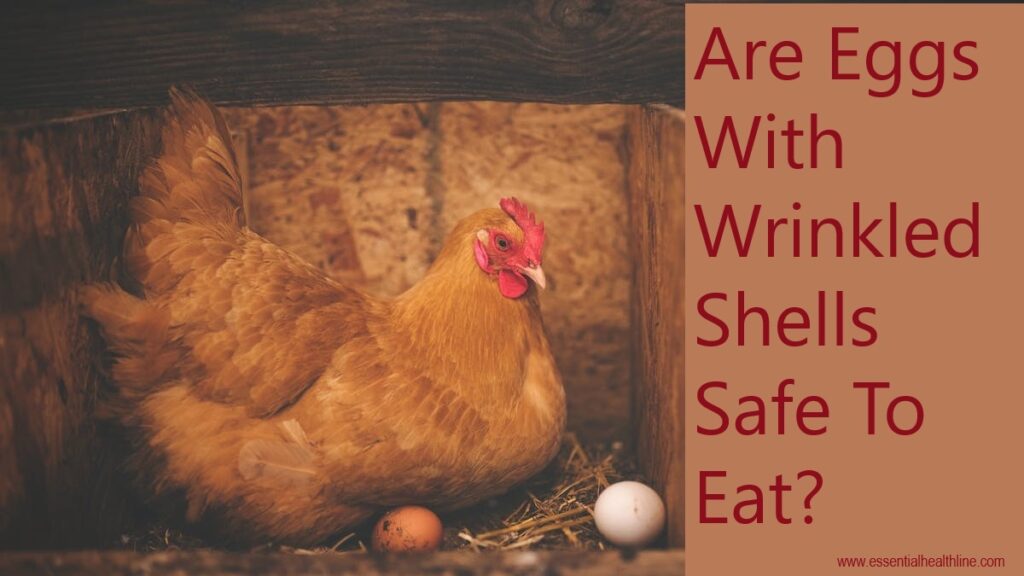Egg wrinkling is one of the potential deformities that can happen to your eggs. While the odd eggs can have various causes, like stress and diseases, sometimes you may not trace the roots. So, are wrinkled eggs safe to eat?
Wrinkled eggs are safe to eat if the shell has no cracks. The eggs’ deformity only affects the shell’s shape, not its inner content. Even so, you should ensure the eggshell is complete, as a slight crack can allow the passage of bacteria into the egg.
This article explores egg wrinkling deformity, potential causes, other egg abnormalities and their causes, and more. Thus, it’ll help you know if to consume or throw away your weird eggs.
Let’s get started.
What Are Wrinkled Eggs?
Wrinkled, soft-shelled, or ‘body-checked’ eggs are misshapen eggs that come naturally from chicken. However, this abnormality is rare in supermarket eggs as they’re below the quality inspection standards. You mostly find them when you buy eggs in bulk locally or own chickens.
The eggs become damaged in the eggshell gland due to stress or pressure due to overcrowding. Egg wrinkles or ridges result from self-repairing cracks formed by stress or pressure. The wrinkles give your eggs an odd appearance, but they are safe to eat if they have no cracks.
Also, diseases can be the cause of egg deformity. Wrinkles can result in shell weakening. Therefore, you should check if an egg is damaged before eating it.
You can quickly identify wrinkly eggs by their visibly noticeable wrinkles and ripples. While some eggs have ripples covering them all over, others may have several ripples at the top.
Are Wrinkled Eggs Safe to Eat?
Yes, wrinkled eggs are safe to eat. However, the odd-shaped eggs are only edible if their shells have no cracks. Even a slightly cracked shell can allow bacteria to get into the egg.
Luckily, your chicken can enjoy the non-edible eggs as a treat instead of going to waste. Even so, you must crack the eggs to prevent your chicken from destroying other eggs when they learn how to break them.
What Causes Wrinkled Eggs?
There are a variety of reasons for your chicken’s wrinkled eggs, including the following:
- Infectious bronchitis
- Age
- Extreme stress
- Reproductive tract issues
- Temperature
- Light
- Watery albumen
- Copper deficiency
Keep reading as we look at each of the possible causes hereunder.
Infectious Bronchitis
Diseases like infectious bronchitis affect the chickens’ ability to lay healthy eggs. The viral infection affects the chickens throughout their lifespan, reducing their ability to produce thick albumen (egg white).
Infectious bronchitis makes it difficult for the shell gland pouch to form a shell properly over the egg white and yolk. As a result, the affected chickens produce wrinkled eggs with a ripple shell.
The viral disease starts suddenly and spreads quickly. Its signs include sneezing, coughing, and throat-rattling sounds more evident at night.
Remedy: Consult your veterinarian or cull the infected chickens.
Age
The most common reason for wrinkly eggs is age. Older hens produce a thinner egg white than the younger ones. Also, egg whites are too watery, a common problem among hybrid layers. The hens are highly likely to produce eggs with a thin shell highly susceptible to wrinkles.
Age-related wrinkling is more common in hens that lay many eggs (more than 300 eggs) per year than occasional layers. As they grow, they produce larger eggs, resulting in thinner shells. The thinness may also occur due to progressive osteoporosis.
Young hens may also produce wrinkled eggs as their reproductive system isn’t fully developed.
Remedy: Maintain an average-age flock.
Extreme Stress
The chickens’ reserved energy is only enough to adapt to minor changes and small, unusual events in her daily tasks. Hence, intense or numerous occurrences may exhaust the reserves, leaving too little energy to handle daily activities such as egg-laying.
Extreme weather, frights, or excitement are the significant causes of stress. Also, it may occur when your chicken reaches peak production and cannot handle the production pace. Too much stress can result in wrinkled or ridged, soft, thin, or no shells.
Also, your eggs may have wrinkles or flat sides if the hen was roughly handled or has flown from a high place and landed hard. Such incidences can damage a developing egg.
Remedy: Remove the stressors.
Reproductive Issues
Your chickens may sometimes produce eggs with double yolks, especially when stressed out. Most of these eggs may have wrinkled shells resulting from their formation process.
The first egg’s shell may fully develop when the other starts forming. As a result, the pressure on both eggs may cause wrinkles due to insufficient room.
Remedy: Stimulate longer days by incrementally increasing your chickens’ exposure to artificial light.
Temperature
Extreme temperatures can cause your chicken to stop laying entirely. Also, too low or high temperatures are uncomfortable for the birds, resulting in wrinkled eggs. Why? The stress affects chicken-egg production.
Hence, you must provide a comfortable environment for your chicken to produce regular eggs.
Remedy: Maintain comfortable temperatures in all seasons.
Light
Insufficient light affects chickens’ laying routines: They may stop laying or produce abnormal eggs if they don’t get enough daylight.
The light stimulates their laying cycles. Therefore, you should add artificial light during winter to de-stress your chicken and maintain regular eggs.
Remedy: Ensure sufficient light supply during the day.
Watery Albumen
Some chickens are naturally ‘born’ with watery albumen, giving their eggs a wrinkled appearance.
Although you may get a few regular eggs, these chickens lay eggs with wrinkles for most of their lifetime (despite their age and health status).
Remedy: Get a breed known to lay quality eggs.
Copper Deficiency
A chicken with substandard copper content may have lower laying capabilities and produce an abnormal shape, texture, and size. Hence, copper-deficient chickens may produce wrinkled eggs.
Remedy: Feed your chickens a well-balanced diet.
What Are the Other Egg Abnormalities?
Other egg abnormalities include the following:
Shell-less Eggs
The eggs have an outer membrane instead of the usual shell. Causes of shell-less eggs include:
- Diseases like infectious bronchitis, egg drop syndrome ’76, avian influenza, and Newcastle disease
- Nutritional deficiencies of vital nutrients like calcium and phosphorous
- Immature shell gland
Soft-Shell Eggs
They differ slightly from the shell-less eggs as they have small calcium deposits on the shell membrane. The soft shells are paper-like and curve inside when you hold the eggs.
Causes of soft-shell eggs include:
- Mycotoxins-contaminated feeds
- Excess phosphorus in the diet
- Hen’s old age
- Moldy feeds
- Salty water
Yolkless Eggs
Also known as fairy, dwarf, fart, or wind eggs are chicken eggs with tiny specimens (small meat spots or flecks) instead of a yolk.
Causes of yolkless eggs include:
- Hormonal imbalance due to drugs and chemicals
- Packaging of loose oviduct tissues as small eggs
- Beginning of a laying cycle by new layers
- End of a laying cycle in old age
Tiny or Undersized Eggs
The eggs are half or a quarter the size of the ordinary ones. They are ideal for a yolk lover since they cover about 60% of the egg.
Causes of undersized eggs include:
- Pullets first egg
- Excessive stress
White-Spotted Eggs
Sometimes, you may find an extra layer of calcium deposits (white spots) of any color on the shell.
Causes of white-spotted eggs include:
- Calcification process disturbances during egg formation
- Too much calcium or vitamin D in the diet
- Defective shell glands
Bloody Eggs
Your eggs might have blood on the eggshells or egg yolks (meat or blood spots).
Causes of bloody eggs:
- Blood-spotted yolk: Bursting of the oviduct’s small blood vessels
- Bloody shell: Overstretching of the chicken’s vent
Brown or White-Specked Eggs
Small calcium deposits may form just below your eggs’ topmost layer (cuticle) but are smaller than the excess calcium deposits. That happens in the shell gland.
Causes of brown or white-specked eggs:
- Disturbances during the calcification process
- Shell’s defectiveness
Slab-Sided Eggs
A second egg enters the shell gland before the exit of the first one. Since the second one isn’t fully calcified, the side that touches the first one flattens and thinnens.
Causes of slab-sided eggs
- Changes in your flock’s house lighting
- Health problems
- Excess stress
Cracked Eggs
Large cracks, hairline, or star cracks appear on the shell and can sometimes result in small holes that allow leakage of the egg content.
Causes of cracked eggs include:
- Calcium or vitamin D deficiency
- Mycotoxins present in the diet
- Salty water for young chicken
- Heat stress
- Hen aging
Wrap Up
Yes, wrinkly eggs are safe to eat. Besides the strange egg appearance, the wrinkles do not affect the quality of the egg content. However, you must inspect the eggs to ensure there isn’t the slightest crack that can allow entry of bacteria.
If you find a crack, all isn’t lost: You can give such to your chicken as a treat. Even so, you should break the shells for them to prevent them from habitually eating good eggs once they learn how to break them.
The possible causes of the odd eggs include diseases, age, excess stress, poor nutrition, harsh weather conditions, and reproductive health issues.
If you have any questions, feel free to reach out to us.



